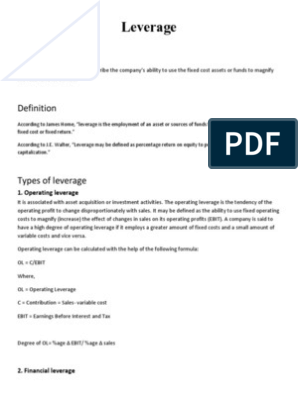4.
Practical Applications in Business
4.1 Operational Leverage in Practice
Industries that have high operational leverage typically invest heavily in fixed assets or infrastructure.
For example:
Manufacturing Companies: These firms often have high operational leverage due to
significant investments in machinery, plants, and facilities. Once these fixed costs are
incurred, increasing production volume leads to a higher contribution margin and greater
profitability.
Technology Firms: Companies in the tech industry often have low variable costs, especially
for software or digital products, which means that once the product is developed, additional
sales do not significantly increase costs.
4.2 Financial Leverage in Practice
Financial leverage is a common strategy in many industries, particularly those requiring substantial
capital investment. For example:
Real Estate Development: Developers often use debt to finance large projects, as the return
on investment (ROI) may exceed the cost of borrowing.
Private Equity Firms: These firms use high levels of financial leverage to buy companies and
restructure them, aiming for significant returns on equity through the sale of the
restructured company.
4.3 Managing the Balance
It is essential for companies to strike a balance between operational and financial leverage. An
optimal level of leverage depends on the company’s risk tolerance, industry, and business cycle.
During economic booms, higher leverage can lead to outsized profits, while during recessions, lower
leverage may reduce exposure to risk.
Conclusion
Both operational and financial leverage are powerful tools that businesses can use to increase their
returns. However, they come with significant risks, especially when sales or earnings do not meet
expectations.
Operational leverage magnifies the effects of sales fluctuations on profits and is particularly
useful for businesses with high fixed costs and high potential for scale.
Financial leverage allows companies to finance growth through debt, amplifying returns for
shareholders but also increasing the risk of insolvency if earnings do not cover debt
obligations.
Understanding both forms of leverage and how they work in tandem is crucial for businesses looking
to navigate the complexities of financial decision-making. By managing both types of leverage
effectively, companies can optimize their performance and mitigate associated risks.























































































